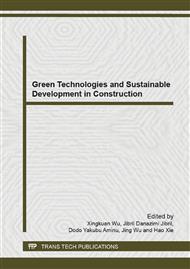p.155
p.159
p.163
p.168
p.172
p.176
p.180
p.184
p.188
The Effects of Oil Palm Shell Aggregate Shape on the Thermal Properties and Density of Concrete
Abstract:
Oil Palm Shell (OPS) are one of low thermal conductivity course aggregate for lightweight concrete. This paper report on all thermal properties parameter, thermal conductivity, specific heat and thermal diffusivity. Tree mixes of OPS of air dry density 1733 to 1811 kg/m3 and oven dry density 1502 to 1632 kg/m3 were prepaid and tested for thermal properties and compared with normal concrete using crushed granite as control and conventional materials. Raw shape with air density 1733 kg/m3 showed the lowest thermal properties with thermal conductivity, specific heat and thermal diffusivity of 0.59 W/mK, 1.352 MJ/m3K and 0.4414 mm2/s, respectively. All OPS mix can be consider as semi structure insulation material as per the RILEM classification which is thermal conductivity lower than 0.75 W/mK. High porosity content in concrete created act as an insulation characteristic and showed OPS have good potential as green insulation materials.
Info:
Periodical:
Pages:
172-175
Citation:
Online since:
May 2014
Authors:
Keywords:
Price:
Сopyright:
© 2014 Trans Tech Publications Ltd. All Rights Reserved
Share:
Citation:


